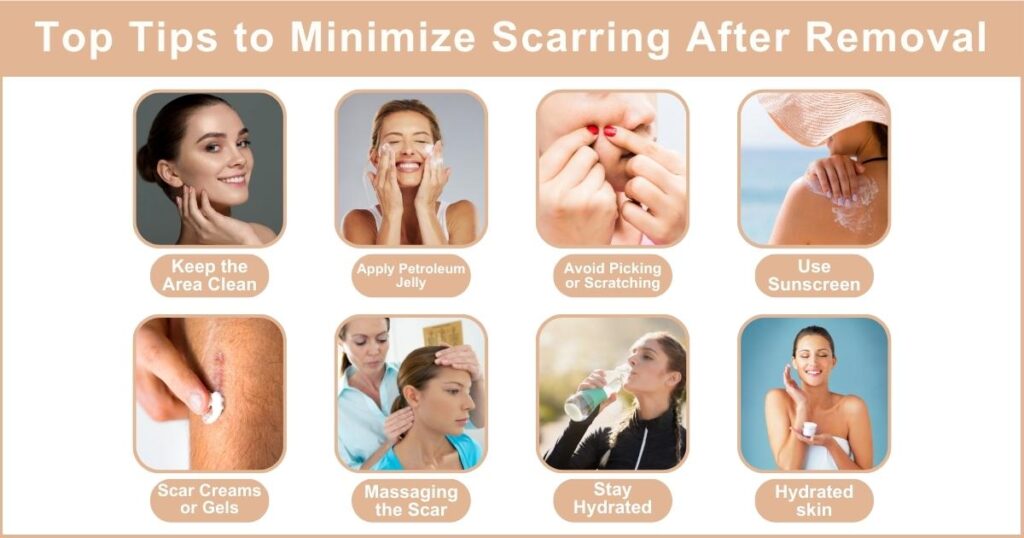Skin tag removal is a common dermatological procedure. Yet, the potential for scarring remains a prevalent concern for many. Thus, the question arises, how can one minimise the possibility of scarring after undergoing skin tag removal? Let’s explore the effective methods that ensure smooth, scar-free skin.
Skin tags appear on various body parts, like the neck, underarms, eyelids, and groin. While these growths don’t usually cause any harm, they can be bothersome or cosmetically undesirable. As a result, many people opt to remove them for aesthetic reasons or to prevent irritation.
However, removal may sometimes leave scars, affecting the skin’s appearance. In this article, we will explore helpful tips to minimise scarring after skin tag removal Dubai, helping you achieve smooth and blemish-free skin.
What are Skin Tags, And How do They Appear?
Skin tags are harmless, small, and have fleshy growth. They are non-cancerous and don’t usually cause any harm or pain. While the exact cause of skin tags is not fully understood, certain factors can contribute to their appearance:
| Factors | Likelihood of Skin Tag Formation |
| Friction | Skin-on-skin or skin-on-clothing friction can create an environment where skin tags are more likely to form. |
| Obesity | Being overweight or obese may increase the likelihood of developing skin tags. |
| Genetics | Some individuals may be genetically predisposed to developing skin tags. |
| Pregnancy | Hormonal changes during pregnancy can contribute to the formation of skin tags. |
| Age | As people age, they may notice increased skin tags. |
Safe and Effective Skin Tag Removal Methods:
The methods for skin tag removal in Dubai involve:
Book A Consultation With Dr Shehzadi Tasneem
Top-rated Plastic Surgeon For Skin Tag Removal in Dubai
Installment Plan Available
Over-the-Counter Creams and Solutions
Various topical creams and solutions available at pharmacies are specifically formulated for skin tag removal. These products usually contain natural ingredients like tea tree oil or salicylic acid, which help break down the skin tag over time, allowing it to fall off painlessly.
Medical Procedures
- Cauterisation: The skin tag is burned off using heat or electricity. The procedure is relatively quick and can be done by a dermatologist in their office. Local anaesthesia is often used to minimise discomfort.
- Cryotherapy: Liquid nitrogen is applied to the skin tag, freezing it and causing it to fall off after some time. A dermatologist also carries out this method, and it is relatively painless.
- Ligation: A small surgical thread or band is tied around the base of the skin tag, cutting off its blood supply. Eventually, the skin tag will wither and fall off. A healthcare professional typically does ligation.
Home Remedies
- Tying Off with Dental Floss: If the skin tag has a narrow base, it can be attempted at home. However, caution must be exercised to avoid infection.
- Apple Cider Vinegar: Applying apple cider vinegar to the skin tag for several days may cause it to dry and fall off.
- Tea Tree Oil: Regular diluted tea tree oil on the skin tag might help reduce its size over time.
The Importance of Minimise Scarring after Skin Tag Removal
The importance of minimising scarring after skin tag removal cannot be overstated, and it revolves around two key aspects:
- Boosts Confidence: Minimizing scarring helps individuals feel more at ease with their appearance, boosting self-confidence and self-esteem.
- Reduces Self-Consciousness: Visible scars can lead to self-consciousness, especially in noticeable body areas, affecting social interactions.
- Prevents Discomfort: After skin tag removal, poorly healed scars may cause discomfort, itchiness, or restricted movement.
- Avoids Keloid Scars: Minimizing scarring lowers the risk of raised and pronounced keloid scars, preventing potential cosmetic and physical issues.
- Promotes Seamless Healing: Proactive scar reduction measures lead to a smoother and more seamless healing process.
- Enhances Emotional Well-Being: Minimizing scarring supports emotional well-being during the recovery period.
- Improves Overall Satisfaction: A reduced appearance of scars increases overall satisfaction with the skin tag removal procedure.
- Encourages Positive Body Image: Minimized scarring encourages a positive perception of one’s body.
- Facilitates Comfortable Clothing Choices: Less noticeable scars allow for greater comfort and confidence in clothing selection.
- Supports Better Skin Health: Minimizing scarring improves skin health after removing skin tags.
Top Tips to Minimize Scarring After Removal

Incorporating these top tips into your post-skin tag removal routine can significantly reduce scarring and promote smoother, healthier-looking skin. Remember that individual results may vary, and it’s essential to be patient during the healing process. If you have any concerns or questions about scar management, consult your healthcare provider for personalised advice.
Keep the Area Clean
Gently clean the treated area with mild soap and water to reduce the risk of infection.
Tips and Tricks
– Wash the area daily with gentle soap and lukewarm water.
– Pat the area dry with a clean, soft towel. Avoid rubbing.
– Avoid harsh cleansers or scrubbing, as it may irritate the healing skin.
Apply Petroleum Jelly
After cleaning, apply petroleum jelly to moisturise the area and aid in healing.
Tips and Tricks
– Use a clean cotton swab to apply a thin layer of petroleum jelly to the scar.
– Reapply the jelly as needed to maintain moisture.
– Petroleum jelly creates a barrier that protects the skin and promotes healing.
Avoid Picking or Scratching
Resist the temptation to pick or scratch at the healing skin, as it can worsen scarring.
Tips and Tricks
– Keep nails short to prevent accidental scratching.
– If itching occurs, gently pat the area instead of scratching.
– Distract yourself to avoid the urge to touch the healing skin.
Use Sunscreen
Shield the treated area from the sun with sunscreen to prevent the darkening of the scar.
Tips and Tricks
– Apply a broad-spectrum sunscreen with SPF 30 or higher to the scar.
– Reapply sunscreen every two hours, especially when outdoors.
– Use protective clothing or seek shade to minimise sun exposure.
Scar Creams or Gels
Consider using scar-reducing creams or gels containing ingredients like vitamin E, aloe vera, or silicone.
Tips and Tricks
– Choose products specifically designed for scar reduction.
– Follow the manufacturer’s instructions for application and frequency.
– Be consistent in using the scar cream or gel for optimal results.
Massaging the Scar
Gently massage the healing area to improve blood circulation and promote tissue repair.
Tips and Tricks
– Use gentle circular motions to massage the scar for a few minutes daily.
– Avoid massaging open wounds or sutures; wait until the area is fully healed.
– Massaging helps break down scar tissue and improve skin texture.
Stay Hydrated:
Drink plenty of water to maintain skin hydration and elasticity.
Tips and Tricks
– Aim to drink at least eight glasses (64 ounces) of water daily.
– Stay hydrated to support the body’s natural healing processes.
– Hydrated skin is more supple and less prone to excessive scarring.
Natural Remedies for Scar Minimisation
These natural remedies complement other scar-minimizing methods and promote healthier, smoother skin. However, individual results may vary, and it’s essential to be consistent and patient while applying these treatments. If you have sensitive skin or allergies, perform a patch test before using any natural remedy on a larger area. If you experience adverse reactions, discontinue use and consult a healthcare professional.
Aloe Vera Gel Application
Aloe vera gel is a popular natural remedy known for its soothing and healing properties. Applying aloe vera gel to the scarred area can help reduce inflammation, promote skin regeneration, and improve the overall appearance of the scar.
Tips and Tricks
– Use fresh aloe vera gel directly from the plant or choose a pure, organic aloe vera gel product.
– Apply the gel gently to the scar and massage it in circular motions until absorbed.
– Repeat the application 2-3 times a day for best results.
Lemon Juice for Natural Exfoliation
Lemon juice contains natural alpha-hydroxy acids (AHAs) that act as gentle exfoliants, promoting the removal of dead skin cells and aiding in scar lightening. It can help fade scars over time and improve skin texture.
Tips and Tricks
– Squeeze fresh lemon juice and dilute it with equal water.
– Using a cotton ball, apply the mixture to the scarred area.
– Let it sit for 10-15 minutes, then rinse with cool water. Avoid sun exposure after application.
Coconut Oil for Skin Rejuvenation
Coconut oil is rich in fatty acids and antioxidants, which can help nourish and moisturise the skin, promoting better healing and minimising scar appearance.
Tips and Tricks
– Warm a small amount of coconut oil in your hands to liquify it.
– Gently massage the oil onto the scarred area in circular motions.
– Allow the skin to absorb the oil fully. Repeat 2-3 times daily for optimal results.
Honey for Wound Healing
Honey possesses natural antibacterial properties and is known for its wound-healing capabilities. Applying honey to the scarred area can aid in reducing inflammation and encouraging the skin’s healing process.
Tips and Tricks
– Choose raw, organic honey for the best results.
– Apply a thin layer of honey directly to the scar.
– Cover the area with a clean bandage to prevent sticking. Repeat daily or as needed.
Onion Extract for Scar Reduction
Onion extract has shown promise in reducing the appearance of scars. Certain components in onions, such as quercetin and sulfur, may help soften and flatten scars over time.
Tips and Tricks
– Purchase onion extract gel or cream from a reputable source.
– Apply a small amount of the extract to the scarred area.
– Gently massage the extract into the skin and let it absorb completely. Use daily for better results.
Oatmeal for Gentle Exfoliation
Oatmeal is a gentle exfoliant that can help slough off dead skin cells and promote skin cell turnover, reducing the visibility of scars.
Tips and Tricks
– Mix ground oatmeal with water to form a paste.
– Gently apply the paste to the scarred area and leave it on for 15-20 minutes.
– Rinse off with warm water, pat dry, and moisturise. Use twice a week for effective exfoliation.
Potato Slice Treatment
Potato slices contain enzymes and vitamins that can aid in scar healing and fading. They also have anti-inflammatory properties that help reduce redness and irritation.
Tips and Tricks
– Cut a potato into thin slices and apply them directly to the scar.
– Leave the slices on for 15-20 minutes before rinsing the area with water.
– Repeat daily for several weeks to see improvements in scar appearance.
Skin tag removal, while beneficial, can raise scarring concerns. You can effectively mitigate these by adhering to cleanliness protocols, applying scar-reducing creams, and shielding your skin from sun exposure. Natural remedies can further diminish scars, granting you clear, healthy skin. Professional healthcare advice is paramount for safe, successful skin tag removal.
Book a consultation with Dr Shehzadi Tasneem Sultan, an esteemed plastic surgeon renowned for her expertise in body contouring, facial rejuvenation, cancer reconstruction, burn management, and microsurgery.
With extensive experience from prestigious institutions like JBRS in Lahore, Pakistan, Great Ormond Street Hospital in London, and St. Thomas and Guys Hospital in London, she offers personalised and accurate treatment plans to meet your needs. Embrace your natural beauty and regain confidence under the care of an experienced surgeon with an artistic eye.
Wondering about the cost of skin tag removal in Dubai? Find out in our blog : Cost of Skin Tag Removal in Dubai












